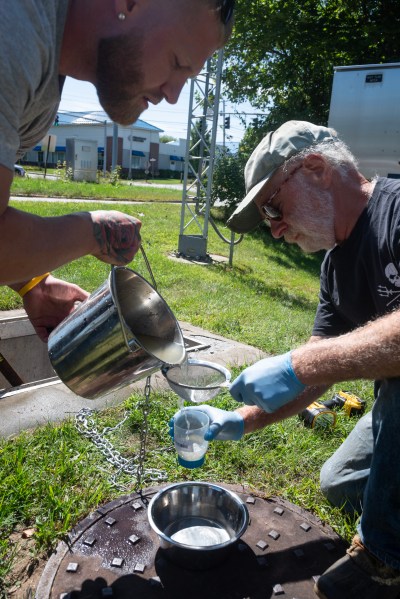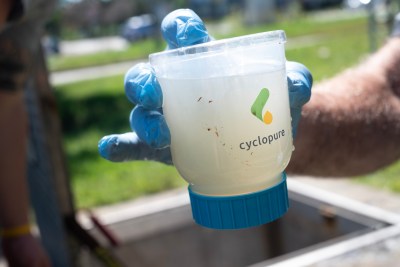Brunswick residents with wells face testing barriers in wake of chemical spill
Concerned Brunswick homeowners with wells near the former air base may have to fork over hundreds of dollars for PFAS testing.

The Maine Department of Environmental Protection said it will consider reimbursing homeowners up to $300 for one set of expensive PFAS well water tests near Brunswick Landing, but only if any PFAS levels resulted from this month’s major firefighting foam spill.
The DEP will still test a select few wells east of the former Naval air base for PFAS in accordance to its still-developing sampling plan, the department said. The DEP will contact these residents directly.
“While the DEP does not believe that any homeowner wells are at risk from this spill, we plan to sample some wells to the east of the spill site out of an abundance of caution,” said DEP Deputy Commissioner David Madore.
How exactly residents can prove any contamination in their well is related to the recent spill and not preexisting is unclear. DEP officials didn’t respond to several messages requesting clarification Thursday.
Those not selected for DEP sampling will have to order testing on their own. Madore said that homeowners who might qualify for reimbursement would also need to do the testing in line with DEP’s sampling guidance at a Maine-accredited lab and send the results to the DEP for review. It is unclear what process determines how any detected PFAS levels in wells could be tied to AFFF.
“I mean, it’s an emotional story to think that where you live is affected and what you drink may be contaminated,” said Chief Executive Officer of Maine PFAS Laboratories Katie Richards. “And I can’t even imagine what it would feel like to be right next to the base and, you know, be thinking about it constantly.”
When Richards considered PFAS testing for herself a few years ago, she described facing several hurdles — not a lot of labs would perform individual tests because they mainly handled commercial level testing and waiting periods for results could be months long.
This was the reason she and her husband, an analytical chemist, founded a state-accredited lab two years ago that provides fast PFAS testing. Her main goal is for people to feel comfortable with where they live.
“My recommendation, in general, is if you have a well and it hasn’t been tested for PFAS, you should test it for PFAS,” Richards said. “Get your baseline test, make sure you’re in good shape.”
One of the largest PFAS-testing barriers posed to homeowners — whether on Brunswick Landing or elsewhere — is the cost. The DEP estimates the prices for just a single test can range from $250–$450, but some say the prices can go even higher.
Brunswick resident Alexandra Plante, who lives southwest of the former air base, said that when she looked into PFAS testing for her well a couple years ago, she felt like the process was “cost prohibitive.” At the time, she said quality testing for the toxic chemical would have cost her family north of $600.
Plante said that in the wake of the spill at Brunswick Landing, she is open to revisiting PFAS testing for her home. Still, she said, the cost will be a barrier for many.
“Even if you do the mail-in option and it’s $295–$300, that’s still really cost prohibitive, I just would say, across the board,” she said. “We have two boys in day care, we have a mortgage, we have taxes, we have gas, we have an oven breaking. Just, on top of everything else, needing to plunk down [a couple] hundred dollars just to confirm safe tap water — it’s a lot.”
Another state and nationally accredited lab — Katahdin Analytical Services, which has about 30 years working with cleanup projects and superfund sites — said that prices also vary based on the materials that are test, which can range from water to soil and tissue testing.
Lab President Michael Flanders said processing tests at the certified labs like Katahdin is expensive because of the instruments and chemicals involved, pay for scientists, and standards used to meet EPA quality regulations. Flanders said the lab understands that testing is expensive and tries to find economical options for homeowners.
“Homeowners also need to be prudent and think about ‘I’m going to take the safer route,’ ” Flanders said, noting that homeowners can assess risk by consulting with the DEP prior to ordering a test. “But I would also caution homeowners: Don’t spend your life savings, because PFAS testing can get expensive.”
The EPA has multiple PFAS drinking water–testing methods for which accredited labs can get certified. Each method can also be “modified” by labs to test for additional PFAS substances not addressed in the EPA method.
The DEP said it plans to use a 537.1-modified method for PFAS sampling of the private wells at Brunswick Landing. Madore said that if the DEP decides that more testing is needed in a well, it could use a more recent method published in January — known as 1633— for a more in-depth sampling.
 There are over 14,700 PFAS substances, according to an EPA chemical database, but each water-testing method analyzes for a limited amount of PFAS that are concerning to human health. Katahdin Analytical Services, for instance, offers multiple methods of testing, including the newer 1633 method. The most common method for well water, Flanders said, is the 537.1-modified method that analyzes for 28 PFAS compounds.
There are over 14,700 PFAS substances, according to an EPA chemical database, but each water-testing method analyzes for a limited amount of PFAS that are concerning to human health. Katahdin Analytical Services, for instance, offers multiple methods of testing, including the newer 1633 method. The most common method for well water, Flanders said, is the 537.1-modified method that analyzes for 28 PFAS compounds.
The 1633 method tests for 40 PFAS compounds known be a threat to human health. Flanders said that with the newer method now published and adopted by federal regulatory groups, the state — namely the DEP — should soon consider the method as a standard for testing.
“That method may be the preferred method for homeowners in the future for well-water drinkers,” Flanders said.
Some scientists and researchers say it’s possible for those facing financial barriers to consider other testing methods before turning to a state-certified testing program.
Dr. Jean MacRae at the University of Maine said that tests like Cyclopure, a company that develops plant-based water treatment for PFAS for $80, can be a cheaper alternative.
“This test is not certified, but it seems to give pretty reliable results, and testing at the certified labs is slow and much more expensive,” MacRae said. “If people do find their water is contaminated, there are treatment systems that can be used at home. When choosing a water treatment system, people should look for options that have been [National Sanitation Foundation] certified for PFAS removal.”
This same test kit is used frequently by Friends of Merrymeeting Bay, a nonprofit that works to protect and monitor resources in the bay. FOMB Chairperson Ed Friedman used a kit for testing at the Sewer District in Brunswick just today. A Cyclopure PFAS compound list provided by FOMB shows that several of the PFAS analyzed in the kit overlap with compounds analyzed in the EPA 1633 method.
‘PFAS, they’re not going to go away’
PFAS contamination concerns continue to grow after initial tests at Brunswick Landing from last week’s disastrous firefighting foam spill — the largest in Maine in 30 years — revealed extremely high concentrations of an especially long-lasting and toxic PFAS chemical known as PFOS, as reported by the Portland Press Herald.
The Portland Press Herald reported that the test revealed there were 3.2 billion parts per trillion of PFOS (perfluorooctane sulfonic acid) in a chemical tank at Hangar 4, where 1,450 gallons of firefighting foam — known as AFFF (aqueous film-forming foam) — concentrate were released in a malfunctioning fire suppression system at Brunswick Executive Airport.
The state has screening guidelines for PFOS remedial action at 1,000 parts per trillion for groundwater leachate, 210 parts per trillion for milk, and 20 parts per trillion for PFOS by itself or combined with five other forever chemicals that are part of the PFAS group, according to the Portland Press Herald. Standards are even stricter for drinking water at 4 parts per trillion. Federal regulators consider just trace amounts of PFAS a health risk.
State and local officials have emphasized that public drinking water is unlikely to be impacted by the spill, which occurred outside of the aquafer used to source water. Some say it will take time to see how PFAS could impact sources of drinking water in the area, given the slow rate of ground water movement.
MacRae said that PFAS from AFFF would need to first stick to soil and then leach into ground water from rain.
“It would be like when you pour water over your coffee grounds,” MacRae said. “It moves pretty slowly, right, because it has to find its way through the coffee grounds and eventually will find its way down to a part lower — so, your coffee pot — where you can think about that as sort of your actual ground water.”
MacRae said that while slow, ground water contamination is less predictable in where it will flow — it percolates through each ground material differently. This is a concern that Richards shares, noting that given the nature of ground water movement, many homeowners have no idea what may be contaminating their private water systems.
Richards also said that with half of Maine’s population on well water, there are so many additional health risks that homeowners are just not aware of. The Maine Division of Community and Environmental Health states that 1 in 10 privately owned wells are contaminated with harmful chemicals such as arsenic, uranium or radon. With PFAS, Richards said it’s best to play it safe.
In bedrock, for instance, water loaded with PFAS could only pass through fractures, which can move in multiple directions. In cases like this, MacRae said it is possible for two houses with bedrock wells to sit side by side and have different exposures to contamination.
“People should be keeping an eye on their water in the area, just because PFAS, they’re not going to go away once they contaminate the ground water system … and [it’s] really hard to predict where exactly they are going to go,” MacRae said. “But if you’re nearby [a PFAS spill], there’s a pretty good chance it could find its way to you.”
